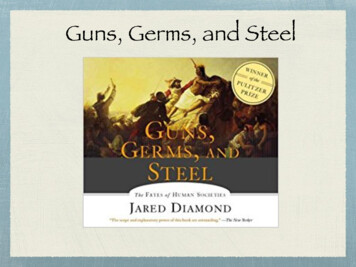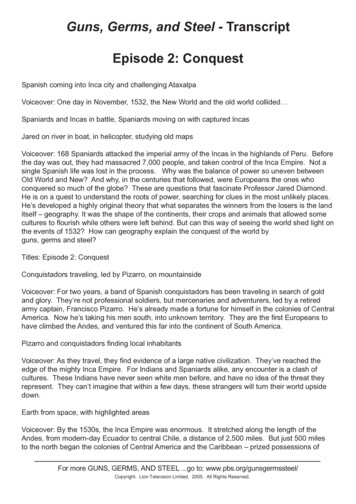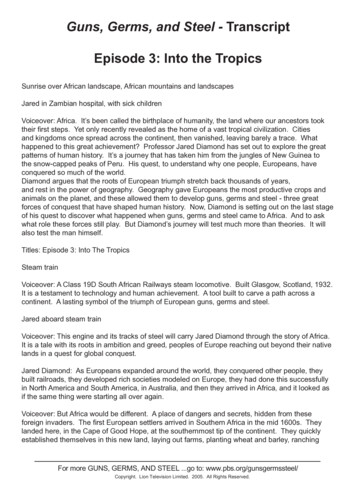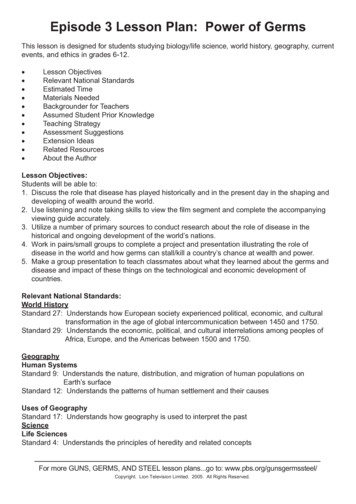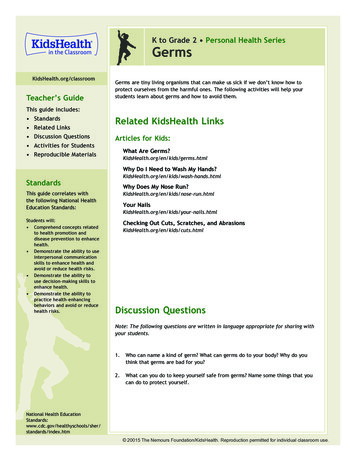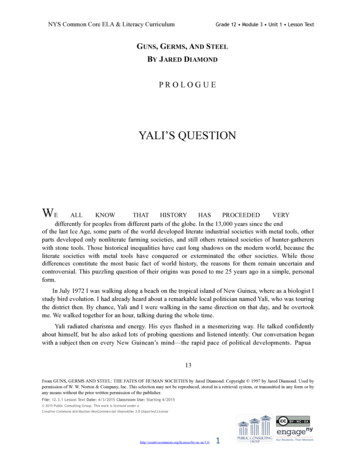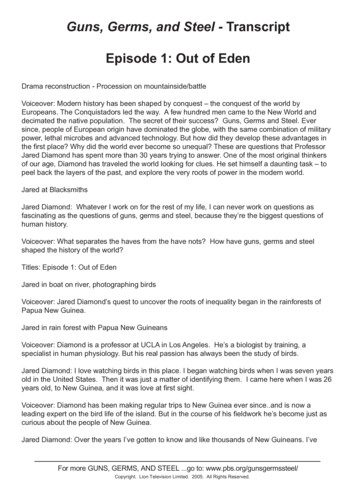
Transcription
Guns, Germs, and Steel - TranscriptEpisode 1: Out of EdenDrama reconstruction - Procession on mountainside/battleVoiceover: Modern history has been shaped by conquest – the conquest of the world byEuropeans. The Conquistadors led the way. A few hundred men came to the New World anddecimated the native population. The secret of their success? Guns, Germs and Steel. Eversince, people of European origin have dominated the globe, with the same combination of militarypower, lethal microbes and advanced technology. But how did they develop these advantages inthe first place? Why did the world ever become so unequal? These are questions that ProfessorJared Diamond has spent more than 30 years trying to answer. One of the most original thinkersof our age, Diamond has traveled the world looking for clues. He set himself a daunting task – topeel back the layers of the past, and explore the very roots of power in the modern world.Jared at BlacksmithsJared Diamond: Whatever I work on for the rest of my life, I can never work on questions asfascinating as the questions of guns, germs and steel, because they’re the biggest questions ofhuman history.Voiceover: What separates the haves from the have nots? How have guns, germs and steelshaped the history of the world?Titles: Episode 1: Out of EdenJared in boat on river, photographing birdsVoiceover: Jared Diamond’s quest to uncover the roots of inequality began in the rainforests ofPapua New Guinea.Jared in rain forest with Papua New GuineansVoiceover: Diamond is a professor at UCLA in Los Angeles. He’s a biologist by training, aspecialist in human physiology. But his real passion has always been the study of birds.Jared Diamond: I love watching birds in this place. I began watching birds when I was seven yearsold in the United States. Then it was just a matter of identifying them. I came here when I was 26years old, to New Guinea, and it was love at first sight.Voiceover: Diamond has been making regular trips to New Guinea ever since.and is now aleading expert on the bird life of the island. But in the course of his fieldwork he’s become just ascurious about the people of New Guinea.Jared Diamond: Over the years I’ve gotten to know and like thousands of New Guineans. I’veFor more GUNS, GERMS, AND STEEL .go to: www.pbs.org/gunsgermssteel/Copyright. Lion Television Limited. 2005. All Rights Reserved.
learned several of the languages, and much of what I know about birds I picked up from them.Voiceover: There have been people living in New Guinea for at least 40,000 years – much longerthan on the continents of North and South America. They’re among the most culturally diverse andadaptable people in the world. So why are they so much poorer than modern Americans? Thequestion was put to Diamond bluntly by a man called Yali, whom he met on a beach more than 30years ago.Yali Voiceover: Why you white man have so much cargo and we New Guineans have so little?Jared Diamond: Yali’s question really threw me. It seemed so simple and obvious, and I thought itmust have a simple and obvious answer, but when he asked me, I had no idea what that answerwas.Yali Voiceover: Why you white men have so much cargo and we New Guineans have so little?Archive: B&W footage plane landing in New Guinea, New Guineans, white man with NewGuineansArchive: B&W still – New Guineans with Western objectsArchive: B&W footage New Guineans carrying goods and white men/with plane/walkingVoiceover: New Guineans use the word cargo to describe the material goods first brought to theircountry by Westerners. Cargo was regarded by many as evidence of the white man’s power. Itwas treated with an almost religious reverence. For their part, Western colonials typically believedthat power was determined by race. They saw themselves as genetically superior to the nativepopulation. To them, it was only natural that they should have so much cargo and New Guineansso little.Jared Diamond: To me, any explanation based on race is absurd. I know too many really smartNew Guineans to believe there’s anything genetically inferior about them. It’s their ingenuity andtheir quickness to learn that have always impressed me. They can go empty-handed into some ofthe most difficult environments on earth, knock up a shelter in a few hours and survive. I wouldn’tknow where to start. In this environment I’d be helpless without them. So why didn’t theseingenious people invent metal tools, or build great cities, or develop any of the other trappings ofmodern civilization?High-speed shots New York City street scenesJared Diamond: The world that I’m from is so different. The modern U.S. is the richest, mostpowerful state on earth. It’s crammed with more cargo than most New Guineans could everimagine. But why? That’s what Yali wanted to know. How did our worlds ever come so different?Ancient Egyptian structuresVoiceover: Diamond realized that Yali’s question was far bigger and more complex than it firstappeared. It was really about the roots of inequality - a question as old as human history itself.Greek and Roman ruins, Mayan sculptureFor more GUNS, GERMS, AND STEEL .go to: www.pbs.org/gunsgermssteel/Copyright. Lion Television Limited. 2005. All Rights Reserved.
Jared Diamond: Why, since ancient times, have some societies progressed faster than others?What allowed the Egyptians to build great pyramids while most of the world was still scratching outa living? How did the Greeks ever develop such an advanced civilization? Or the Romans? Or theMaya?Jared Diamond: All great civilizations have had some things in common – advanced technology,large populations, and well-organized workforce. If I could understand how those things came intoexistence, then I’d understand why some people marched faster than others during the course ofhistory.Globes in darkened room, pan across to Jared readingVoiceover: Diamond set out to explore the division of the world into haves and have nots. Itwas a massive challenge that few scholars would have dared take on. He was a scientist, not ahistorian. How could he possibly solve the great puzzles of human history?Graphic showing earth from spaceVoiceover: To understand where inequality came from, Diamond needed to identify a time beforeinequality, when people across the world were living more or less the same way. He had toturn back the clock thousands of years, back before the first civilizations. Back into prehistory.13,000 years ago, the ravages of the last Ice Age were over. The world was becoming warmerand wetter. One area where humans were thriving was the Middle East.13,000 years ago, theMiddle East was far less arid than today, with more forests, trees and plants. People here livedlike people everywhere at this time – as hunter/gatherers in small, mobile groups. They werefrequently on the move, making shelters wherever they could find animals to hunt or plants togather. They’d live in these shelters for weeks or months at a time, as long as they could keepfeeding themselves. But as seasons changed and animals migrated, they’d move on, to the nextvalley or ridge, looking for new sources of food.New Guineans and Jared hunting in rainforestVoiceover: One of the few places on earth where it’s still possible to find people hunting andgathering is the rainforest of Papua New Guinea.Jared Diamond: Instead of just reading about this lifestyle in archaeological books, I’ve beenlucky enough to witness it first hand, to see for myself how we all lived 13,000 years ago, andhow we found food. To catch an animal requires skill, stealth, and encyclopedic knowledge abouthundreds of animal species. You have to be pretty smart to be a hunter.Early Middle Eastern people hunting deerVoiceover: 13,000 years ago, people in the Middle East hunted in the same way, tracking downwhatever game they could find. But the fundamental problem with hunting is that it’s never been aproductive way to find enough food. It takes time to track each animal. And with a bow and arrow,there’s no certainty of how the hunt will end.Jared learning to fire arrows with New GuineansVoiceover: Because hunting is so unpredictable, traditional societies have usually relied moreFor more GUNS, GERMS, AND STEEL.go to: www.pbs.org/gunsgermssteel/Copyright. Lion Television Limited. 2005. All Rights Reserved.
on gathering. In this part of Papua New Guinea, the gathering is done by women. An importantsource of food here is wild sago. By stripping a sago tree they can get to the pulp at the centre,which can be turned into dough and then cooked. Although it’s physically harder work, gatheringis generally a more productive way of finding food than hunting. But it still doesn’t provide enoughcalories to support a large population.Jared Diamond: This jungle around us, you might think it’s a cornucopia, but it isn’t. Most of thesetrees in the jungle don’t yield, don’t give us anything edible. There were just a few sago trees, andthe rest of these trees don’t yield anything that we could eat.And then sago itself has got limitations – one tree yields only maybe about 70 pounds of sago. Ittakes them three or four days to process that tree, so it’s a lot of work really for not a great deal offood, plus the sago starch is low on protein, and also the sago can’t be stored for a long time. Andthat’s why hunter/gatherer populations are so sparse. If you want to feed a lot of people, you’vegot to find a different food supply, you’ve got to find a really productive environment, and it’s notgoing to be a sago swamp.Cereal crop being harvestedVoiceover: In the Middle East, there were very different plants to gather. Growing wild betweenthe trees were two cereal grasses, barley and wheat. Far more plentiful and nutritious than sago.These simple grasses would have a profound impact, setting humanity on the course towardsmodern civilization. But it would take a catastrophic change in the climate before this wouldhappen.Graphic showing earth from space with ice spreadingVoiceover: 12,500 years ago, the world’s climate became highly volatile. The long-term thaw thathad brought about the end of the last ice age suddenly went into reverse. Global temperaturesdropped, and ice age conditions returned.Rocky mountainsides with people standing and walkingVoiceover: The world became colder and drier. The Middle East suffered an environmentalcollapse. Animal herds died off. So did many trees and plants. The drought lasted for more than1,000 years. People were forced to travel farther and look much harder for any source of food.But despite the conditions, they would somehow survive, even prosper. Here in the Middle East, anew way of life would come into being, one that would change the face of the earth.SUV driving through desert to dig site, Ian Kuijt drivingVoiceover: Ian Kuijt is a Canadian archaeologist who specializes in the Stone Age history ofthe Middle East. His work has focused on a site in the Jordan Valley, near the Dead Sea – aplace known as Dhra’. Kuijt is a co-director of the dig, and works with an international teamof archaeologists. They’ve uncovered the remains of ancient dwellings that were clearly moresophisticated than any hunter/gatherer shelters. They believe this was a small village, one of theearliest permanent villages anywhere in the world. People were starting to put down roots.Dr Ian Kuijt, Notre Dame University: What we would have had is this village of, I don’t know, 40,50 people, living in the same place. We would have had a series of oval huts that would havebeen partially cut into the ground, and these would have been very much the, the first time peoplesettled down and lived in communities in a really extensive way.For more GUNS, GERMS, AND STEEL .go to: www.pbs.org/gunsgermssteel/Copyright. Lion Television Limited. 2005. All Rights Reserved.
Voiceover: When they radiocarbon dated the site, they discovered that the village first emerged11,500 years ago – at the same time as the end of the drought in the Middle East. But how wasit possible to feed an entire village if times were so hard? After four years of digging at Dhra’, thearchaeologists believe they have an answer. It lies in this unique structure.Ian Kuijt: What you can see here is the outline of a mud wall coming all the way round here, andthen inside we have a series of upright stones that have been chipped in such a way where youcan see a notch on them, and there would have been a series of beams over the top of that,with a floor across it, and basically you would have had a dry, humidity-controlled environment,where they could take grain, they could take any plants, they could dry them out, put them inhere, protect them from insects, protect them from moisture, protect them from water percolatingthrough. What that ends up being from our perspective is probably the world’s first granary insome form – a place where they were able to store food at a particular location on a year-roundbasis.Computer Generated Image showing likely construction of original building, people harvestinggrain, mountain-sides, people sowing cropsVoiceover: The team at Dhra’ believes the granary was an oval-shaped mud wall building at thecentre of the village; a place where grain could be stored collectively. And the grains that werebeing stored were primarily wheat and barley. While other plants were no longer available, thesecereal grasses were hardy enough to survive, and durable enough to be stored for years. But ifthis was a time of scarcity, how was there enough grain to fill a granary? The answer suggestsa radical shift in human behavior. At some point during the drought in the Middle East, peoplestarted growing their own food. Unable to maintain a mobile way of life, they would have stayedclose to any source of water they could find, and planted new fields of wheat and barley aroundthem.Ian Kuijt: Rather than just following food sources around different locations, for the first time whatpeople start to do is that they bring these resources back to them. Not just as harvested food, butthey’re bringing them as seeds, and they’re growing them next to their village, and that’s the firsttime, really this is the first time we see this anywhere in the world.Voiceover: The Stone Age people of the Middle East were becoming farmers – the first farmers inthe world.High-speed footage of plants growingVoiceover: Without realizing it, these new farmers were changing the very nature of the cropsaround them. With every round of planting and harvesting, they’d favor ears of wheat and barleywhose seeds were the biggest, tastiest or easiest to harvest. Traits that were useless to the plantin the wild thrived under human cultivation.Ian Kuijt: They interrupted the cycle. They interrupted the normal environmental cycle andstarted to select these individual plants and basically rewarding those that were going to be mostprofitable to them, and so even though it was accidental, once that whole process started, peoplewere starting to control nature.For more GUNS, GERMS, AND STEEL .go to: www.pbs.org/gunsgermssteel/Copyright. Lion Television Limited. 2005. All Rights Reserved.
Crop laboratory with scientists working and early Middle Eastern crop harvestingVoiceover: The way crops are changed by human interference is known as domestication. Todayit happens in research labs, with scientists selecting genes and breeding crops to be ever moreuseful to humans. It’s a very precise, deliberate process. But not so different from what the firstfarmers were doing unconsciously, thousands of years ago in the Middle East.Jared in boat on river, New Guineans hunting, Women with sago, Plane taking off, View fromairplaneJared Diamond: The transition to farming was clearly a decisive turning point in human history.People who remained hunter/gatherers couldn’t produce anywhere near as much food as farmers,and also couldn’t produce much food that could be stored. They were always going to be at achronic disadvantage. Now I needed to know where else in the ancient world people had becomefarmers. If I could establish links between the spread of farming and the spread of civilization, I’dbe well on my way to answering Yali’s question.Graphic showing earth from space with areas of crop cultivationVoiceover: There are only a few parts of the ancient world that developed farming independently.Not long after the Middle East came China, where people grew another high yield cereal grass –rice. Pockets of farming also emerged in the Americas, based on corn, squash and beans. Later,in Africa, people farmed sorghum, millet and yams. And in most places where farming emerged,a relatively large, advanced civilization followed. But there was an exception to the rule. An areawhere farming didn’t bring the same benefits – the highlands of New Guinea.View of New Guinea from plane, New Guinean farmers workingVoiceover: For 50 years after Westerners colonized New Guinea, they thought the highland valleysin the interior were uninhabited. In fact, they were the most densely populated part of the island,with one of the oldest systems of farming in the world. Archaeologists now believe that peoplehave been farming here for almost 10,000 years – almost as long as the people of the MiddleEast.Jared with crowd of New Guineans, New Guinean farmers workingJared Diamond: It’s amazing to think that these people, Yali’s people, were some of the earliestfarmers in the world. But if they were farmers, why weren’t they propelled down the same pathtowards civilization as the people of the Middle East or China or Central America? Why didn’t theyend up producing their own cargo?Voiceover: New Guinea farmers themselves were surely no less talented than farmers anywhereelse in the world. So what was the difference?Jared Diamond: Highland agriculture was based on crops like these taro roots, which are verydifferent from cereal crops. Taro is much more work. You’ve got to plant it one by one, unlikewheat where you throw your hand and spread the seed, and these New Guinea crops can’tbe stored for years the way wheat can – they rot quickly, they have to be eaten in a short time.They’re also low in protein compared to wheat, so these farmers of the New Guinea highlandssuffered from protein deficiency.For more GUNS, GERMS, AND STEEL .go to: www.pbs.org/gunsgermssteel/Copyright. Lion Television Limited. 2005. All Rights Reserved.
People tending banana crops, giant spidersJared Diamond: There’s not much protein to be gotten from New Guinea’s other crops, either.People here farm local varieties of bananas, but although bananas are rich in sugar and starch,like taro they’re low in protein. In fact, people in the highlands have so little protein that sometimesthey eat giant spiders to supplement their diet.Jared studying in roomJared Diamond: I’d reached a moment of realization. Farming was clearly crucial to the story ofhuman inequality. But, just as important was the type of farming. People around the world whohad access to the most productive crops became the most productive farmers.Voiceover: Ultimately it came down to geographic luck.Archive: B&W footage mechanized crop harvesting, B&W footage bread production, B&W footagetrains and cars, B&W footage New GuineansEarly Middle Eastern crop harvestingVoiceover: It’s an audacious idea that the inequalities of the world were born from the cropswe eat. According to Jared Diamond, Americans have had an advantage over New Guineansbecause for centuries they’ve grown crops that are more nutritious and productive. Crops likewheat, which provides about a fifth of all the calories they eat. The wealth of modern Americacould never have been sustained by taro and bananas. But Diamond’s idea seems almost toosimple. Could plants alone really have the power to shape the course of human history? Or wasthere something else at play? Another reason for the division of the world into haves and havenots?Woman grinding corn, people harvesting crops, goats being herdedVoiceover: By 9,000 years ago, the first settlements in the Middle East were giving way to muchlarger villages. People were only able to live on this scale by becoming more productive farmers.They were surrounded by fields of domesticated wheat and barley,but by now they also had another steady source of food.Dr Louise Martin, Institute of Archaeology, University College London: What we see happeningabout 9,000 years ago is a remarkable transformation in the way that humans are interacting withanimals. We begin to see a process of animal domestication, by which we mean humans werecontrolling where they were moving, they were controlling their feeding, and they were controllingtheir breeding. Instead of having to go out to hunt, you have a dependable meat supply on thehoof, year-round, around your site, rather than being subject to seasonal variations in wild game.Goats being milked and combedVoiceover: As well as meat, animals could be used for their milk, providing an ongoing source ofprotein. Their hair and skins could be used to make clothes for extra warmth. Over time, domesticanimals became an integral part of the new agricultural way of life.Goats being watched, people harvesting cropsFor more GUNS, GERMS, AND STEEL .go to: www.pbs.org/gunsgermssteel/Copyright. Lion Television Limited. 2005. All Rights Reserved.
Louise Martin: We know that the communities which first started to have domestic animals alreadyhad cereal crops, so they were cultivators, and the combination of these particular animals andplants becomes an extremely attractive package, in that they’re complementary. After the harvestperiod, animals could be turned out on the stubble, and they can actually eat the remains of thecereal crop harvest. In their turn, animal dung can be used to provide sort of a fertilizer for thecereal crops as well, the crops, so the whole, the whole package, you know, is seen to be mutuallybeneficial, both for the animals and the plants and of course for the humans.Goats being milked and combed, Goats, sheep, pigs and cattle in fields, Mules pulling ploughs,New Guinean farmers working, with pigVoiceover: Goats and sheep were the first animals to be domesticated in the ancient world, andwere eventually followed by the other big farm animals of today. All of them were used at firstfor their meat, but they all prove useful in other ways, especially with the invention of the plough.Before the industrial revolution, beasts of burden were the most powerful machines on the planet.A horse or an ox, harnessed to a plough, could transform the productivity of the land, allowingfarmers to grow more food and feed more people. In New Guinea and many other parts of theworld, people never used ploughs because they never had the animals to pull them.Pigs, New Guinean men carrying poles and farmers workingJared Diamond: The only big domestic animal in New Guinea was the pig, and it wasn’t evennative - it came in from Asia a few thousand years ago – while Europe and Asia had not only pigsbut also cows, sheep, goats, horses, buffalo, camels and so on. Now pigs do give you meat, butpigs don’t give you the other products that you get from those European and Asian animals.Voiceover: Pigs don’t give you milk, or wool, or leather or hides, and most important of all, pigscan’t be used for muscle power – pigs don’t pull ploughs or pull carts. The only muscle power inNew Guinea was human muscle power.Jared studyingJared Diamond: Even today, there are no beasts of burden in New Guinea, and almost all of thefarm work is still done by hand. But if farm animals were so useful, why didn’t New Guineansdomesticate any of their own? I decided to add up all the animals in the world that have ever beendomesticated, and I was amazed by what I found.Animals of all kindsArchive: B&W footage people chasing elephantsVoiceover: There are nearly two million known species of wild animals, but the vast majority hasnever been farmed. Most insects and rodents are of no practical use to humans, and not worththe effort of farming. Some birds, fish and reptiles have been domesticated, but most are simplyimpractical to farm. So are most carnivores, not because they’re dangerousbut because you’d have to grow other animals just to feed them. The best animals to farm arelarge, plant-eating mammals. And over the years, humans have probably tried to domesticate allof them, usually without success. Despite repeated efforts, Africans have never domesticated theelephant.For more GUNS, GERMS, AND STEEL .go to: www.pbs.org/gunsgermssteel/Copyright. Lion Television Limited. 2005. All Rights Reserved.
Elephants at workVoiceover: In South Asia, some elephants are used as work animals. But they’re not farmed forthe purpose. Instead, each elephant is caught in the wild and then tamed and trained. It doesn’tmake economic sense to farm an animal that takes some 15 years to mature and reach an agewhere it can start reproducing.Horses in corral, Goats, Sheep, Camels, Water buffalo, CattleLouise Martin: Animals which made suitable candidates for domestication can start giving birthin their first or second years. They will have one or maybe two offspring a year, so they’reproductivity is actually high. Behaviorally they need to be social animals, meaning that the malesand the females and the young all live together as a group, and they also have an internal socialhierarchy, which means that if humans can control the leader, then they will also gain control overthe whole herd or whole flock.Wild animals, ZebraVoiceover: There is another crucial requirement for a domestic animal. It needs to get alongwith humans. Some animals don’t have the temperament to live on a farm. A zebra could bean ideal domestic animal, potentially as useful as a horse. But evolving in the midst of Africa’sgreat predators, zebras have become flighty, nervous creatures. They have a vicious streak thathumans have been unable to tame. That may be why zebras have never been harnessed to aplough or ridden into battle.Montage: Wild animals, Domesticated animalsGraphic showing earth from space with highlighted areasJared Diamond: I counted up 148 different species of wild, plant-eating terrestrial mammals thatweighed over 100 pounds, but of those 148, the number that has ever been successfully farmedfor any length of time is just 14.Voiceover: Goats, sheep, pigs, cows, horses, donkeys, Badrian camels, Arabian camels, waterbuffalo, llamas, reindeer, yaks, nithans, and bally cattle. Just 14 large domestic animals in 10,000years of domestication. And where did the ancestors of these animals come from? None wasfrom New Guinea, or Australia. Or Sub-Saharan Africa, or the whole continent of North America.South America had the ancestor of just one large domestic animal; the llama. The other 13 wereall from Asia, North Africa and Europe. And of these, the big four livestock animals; cows, pigs,sheep and goats, were native to the Middle East. The very same area that was home to someof the best crops in the world was also home to some of the best animals. Little wonder that thisarea became known as the Fertile Crescent.Sky, tilt down to village ruins with man walking, Man sowing seed, Goats, Guar site with ruinsVoiceover: The people of the Fertile Crescent were geographically blessed, with access to someof the best crops and farm animals in the ancient world. It gave them a huge head start. Whathad begun with the sowing of wheat and the penning of goats was leading towards the first humancivilization. The archaeological site of Guar in Southern Jordan is 9,000 years old. But it has allFor more GUNS, GERMS, AND STEEL .go to: www.pbs.org/gunsgermssteel/Copyright. Lion Television Limited. 2005. All Rights Reserved.
the hallmarks of a town. A few hundred people lived here, in rows of houses that were a wonder oftechnology.Dr Mohammad Najjar, Department of Antiquities, Jordan: Every time I come here, I’m amazed bywhat those people were doing. Some of the houses have a kind of air conditioning, a, this windowhere is for, to control the air coming from the street inside the house, and the houses, the wallsand the floors of the houses from the inside at least, were covered with plaster.People plastering wallsMohammed Najjar: So people were moving to a concept of homes. It’s, it’s not a place just tosleep, it is a proper home, and people started to decorate the houses from the, from the inside,and people were starting to invest in their homes, because if we are talking about plaster, it istime-consuming, it’s effort-consuming – it’s very expensive to have plastered house.People sowing seeds, making cement, weaving, making plasterVoiceover: As villages grew bigger, there were more people to work on the land. More peoplecould produce more food more efficiently – enough to support specialists within the community.Freed from the burden of farming, some people were able to develop new skills, and newtechnologies. Making plaster from limestone was a major technological breakthrough. The stoneshad to be heated for days at a time, at a temperature of 1,000 degrees. It may seem insignificanttoday, but understanding how to work with fire was the first step towards forging steel – atechnology that would transform the world.People making steelMontage: steel-based products in useMountains of New Guinea, New Guinean farmers workingVoiceover: By contrast, places like New Guinea never developed advanced technology. Eventoday, some people in the highlands are working in ways that have barely changed for centuries.Archive: B&W footage New Guineans working, Jared with axe, New Guinean farmers workingJared Diamond: When I first came to New Guinea in the 1960s, people were still using stonetools like this axe in parts of the island, and before European arrival, people were using stonetools everywhere in New Guinea. So why didn’t New Guinea develop metal tools by itself? Andeventually I realized that to have metalworking specialists w
Guns, Germs, and Steel - Transcript Episode 1: Out of Eden Drama reconstruction - Procession on mountainside/battle Voiceover: Modern history has been shaped by conquest - the conquest of the world by Europeans. The Conquistadors led the way. A few hundred men came to the New World and decimated the native population. The secret of their success?
